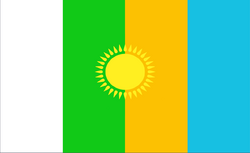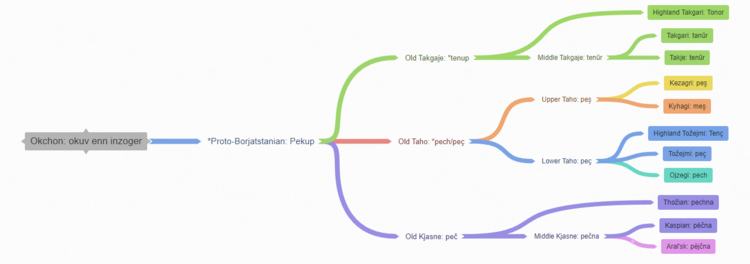Borjatstans
This article is incomplete because it is pending further input from participants, or it is a work-in-progress by one author. Please comment on this article's talk page to share your input, comments and questions. Note: To contribute to this article, you may need to seek help from the author(s) of this page. |
United Republics of Borjatstans Борятстандар, Borjatstanlar, Borjatstans, Borjatstans, Борятстанхо, Ÿ'e Borjatstans, Ÿ'ï Borjatstans | |
|---|---|
|
Flag | |
| Anthem: Greatest Country under the Steppe Sun | |
 | |
| Location | Middle Western Elisia, west of Lake Okchon |
| Capital and | Almaty |
| Official languages | Kezagri Ojzegi Tozhejmi Kyhagi Takgari Takje Kaspian Aral'sk |
| Ethnic groups (2026) | 18.6% Kezagri 15.9% Tozhejmi 15.6% Kyhagi 12.7% Ojzegi 12.4% Kaspian 11.0% Aral'sk 10.9% Takgari 2.3% Takje 0.2% Other |
| Religion (2026) | 46% Half Zher'dorox 31% Zher'dorox 14% Kjasne Religion 8.4% Non-Religious 0.6% Other |
| Demonym(s) | Borjatstanian |
| Government | Presidental Federation |
| Borjat Serkov | |
| Vali Komilov | |
| Establishment | |
• First humans ariving to Borjatstans | around 3000 B.C.E |
• Communist Revolution and Unification | 11th January 1922 |
• Democratic Revolution | 13th Aipril 1945 |
| Area | |
• Total | 2,435,440.93 km2 (940,329.00 sq mi) |
| Population | |
• 2025 census | 76.1 Million |
• Density | 31.25/km2 (80.9/sq mi) |
| GDP (PPP) | 2025 estimate |
• Total | 2,578,000,000 Rovas |
• Per capita | 34,000 Rovas |
| GDP (nominal) | 2025 estimate |
• Total | 2,283,000,000 Rovas |
• Per capita | 30,000 Rovas |
| Gini (2025) | 29.7 low |
| HDI (2025) | high |
| Currency | Borjatstanian Soumid (Ś) (SMD) |
| Time zone | UTC-3:30 (BST) |
| Date format | dd/mm/yy |
| Driving side | right |
| Calling code | +44 |
| Internet TLD | .br |
Borjatstans (Kjasne languages: ['borjat.stans]; Kezagri: ['bord͡ʒat.stans]), officialy the United Republics of Borjatstans or semi-officialy the Federation of Borjatstans is a landlocked country located in western middle of Elisia, west of Lake Okchon (Eastern Sea in Borjatstanian languages). It borders (unclaimed lands). Its capital and Borjatstans' largest city is Almaty since 1922. Borjatstans is the world's largest landlocked country when not including nations on Lake Okchon. It has population of 76.1 million people, with 31.25 people per square kilometer. It is founding member of Almaty Pact and member of Telrovan Assembly.
Etymology
The name "Borjatstans," rooted in the traditional Borjatstanian language, is a combination of two linguistic elements. The first component, "Borjat," hails from ancient Kaspian and signifies "good" or "positive." The second part, derived from trans-Borjatstanian, employs "stans," the plural form of "stan," denoting "Land," "Realm," or "Nation." Consequently, the composite term "Borjatstans" can be translated as "Lands of Good. The term "Borjatstans" first surfaced in historical records during the 1100s in the Olov empire.
History
Borjatstans has been inhabited since approximatly 3,000 years B.C.E. The Okchonic culture was the first to settle in Borjatstans at that time, which over around 2,800 split into more distinctive tribes.
Indenegous Tribes
In 3rd-1st Century B.C.E. an larger number of people from Okchonic descend settled in the areas close to the Great Lakes. Starting as fishers, hunters and gatherers. After the agricultural revolution got to Boratstans those tribes started to stay in one place and started to farm on the fertile land along the Great Lakes and rivers and divert into smaller groups.
Early Medival Era
At the start of "Early Medival Era" (0 B.C.E. to 1102 C.E.) lot of tribes joined into duchies and small kingdoms. Lot of wars for land and "racial purity" happened in this era. End of the Early Medival Era is generaly agreed by historians to be the fall of Olok Empire in 1102.
Medival Era
The era of true medival times from 12th to 16th century with lot of merchants trading technology and stuff into and out of Boratstans. It has been age of both golden ages and wars.
Late Medival Era
Lasten from 16th century to 18th century. As the technology in Telrova advanced the ideologies in Boratstans got more extreme. This was last age of cruel wars and castles.
First Era of Isolationism
Lasted from 18th Century to 1/2 of 19th century century. Lot of radical ideologies arosed in this time and lot of Kindgoms and new republics were xenophobic againts foreigners.
Industrial Revolution 1850s-1919
In this short era the industrial sector of Boratstans was extremely boosted and lot of past Xenophobia went away as the rapidly industrializing nations needed resources. Some radicalistic (mainly extreme-left) beliefs were still enforced by some groups. Most known was the Kezagri Communist Party, later Boratstanian Communist Party. In this era lot of new technologies started being used, for example the steam engine. Steam engines made the so-called "Sea Liners" faster and could hold more passangers. First ever flying craft was also build in Tozhejmistan, which was a small Airship (Skyship called by engineers in Borjatstans) used for bombing.
War of the Boratstanian Sunfall 1920-1922
From 17th October 1920 to 11th January 1922, the last war of the Pre-united Boratstans happened, called the "War of the Boratstanian Sunfall". There was the democratic/monarchistic side, mainly comprised of Southern Boratstans Anti-Communist Coalition versus communist Nothern Boratstans lead by historical dictator, Highest Comrade Taras Amanetev. The war has been deadly and long. The more industrialized and militarized Nothern Boratstans won, annexing all lands of Boratstans and estabilishing first ever united Boratstanian country, under communist regime lead by Taras Amanetev and after Amanetev's death, by Abzal Assylev.
Communist Government 1922-1945
After the War of the Boratstanain Sunfall, the Boratstans was under single rule of communist regime under Highest Comrade Taras Amanetev. In this era, heavy oprresion has been put over people. Those who didn't follow orders or fighted the regime were send to "Re-education camps" which have been torture camps in reality.
Democratic Revolution and Early United Democratic Era 1945-1980s
In the 1944 Highest Comrade Taras Amanetev died and was replaced by the Second, Highest Comrade (and last one) Mr. Abzal Assylev. His new government was weaker and corruption made the military incomenent. An Democratic Revolution happened, overthrowing the communist and estabilishing new and more democratic government. First 40 years were time of rebuilding and catching up with foreign world. In the 1980's Boratstans finaly opened to world and started to expand theyre Foreign Affairs, both good and bad.
Modern Age 1980s-today
This is the current age of Boratstans. Boratstans growing democratic federation/union with funcional space program, welfare programs and more. Some parts of the nation still are full of poverty but those pockets are shrinking.
Geography
Boratstans, a country located in Telrova in the western middle of Elisia, is known for its diverse geographical features. The country boasts of hot plains and steppes in the north, extensive forests and plains in the central region, and mountains with needle-leaf forests in the south. Most of the country's population and lot of endemic species of fauna and flora are concentrated around the Great Seas (Aral'sk Sea and Kaspian Sea), which are large freshwater lakes colloquially referred to as "Seas" due to their vast expanse.
The highest peak in Boratstans is Mount Quill, towering at an impressive 3671 meters above sea level. It is located in South Takgaristan, one of the seven republics that constitute the country.
Government
Economy
Demographics
Population of Boratstans in 2025 was 76.1 Million. Population growth is estimated to be around 0.4%. Boratstans has 8 major ethnicities (8 counting Takje) which divide into the Kjasne ethnicities (Kaspian and Aral'sk) the Taho languages ethnicities (Kezagri, Ojzegi, Tožejmi, Kyhagi) and Takgari-Takje ethnicities (Takgari, Takje).
| Origin | Population in millions |
|---|---|
| Kezagri | 14.2 |
| Ojzegi | 9.7 |
| Tozhejmi | 12.1 |
| Kyhagi | 11.9 |
| Takgari | 8.3 |
| Takje | 1.8 |
| Aral'sk | 8.4 |
| Kaspian | 9.5 |
| Other | 0.2 |
Languages
Borjatstans is known for its large variety of languages, all are divided into 4 major language groups; Kjasne languages, Upper Taho languages, Lower Taho languages, and Takgaje languages.
West Kezagri, Steppe Kezagri, East Kezagri, Kyhagi and South Kyhagi fall under Upper Taho languages
North Aral'sk, South Aral'sk, Kaspian and Thožian fall under Kjasne languages
Ojzegi, Tozhejmi and Highland Tozhejmi fall under Lower Taho languages
Takgari, Highland Takgari and Takje fall under Takgaje languages
Religion
Major religion is the Zher'dorox and its branch Half-Zher'dorox.
Culture
Administrative Division
In Boratstans, the highest division of land is known as a Republic, of which there are a total of seven. These Republics include the Kezagristan Republic, Ojzegistan Republic, Tozhejmistan Republic, Kyhagistan Republic, Takgaristan Republic, Kaspian Republic and Aral'sk Republic.
Foreign Relations
Nibelia: It is considered as trade partner of Boratstans.
Nova Cameroon: Boratstans sends humatiarian aid to it. It is Almaty Pact member.
Union-Siberian Socialist-Monarchy: It is partner nation of Almaty pact. Boratstans considers them as little more than neutral country.
The Celtics: Public opinion on Boratstans is worse, after the Accident of Boratstanian A-25-Speedbird crashed into an Celtic's navy battleship.
Saint Perry: It is member nation of the Almaty Pact. It is Boratstans trade partner. The Government and People of Boratstans have positive opinion on them.
Scorpian Federation: After the war the relations are healing, Scorpia was allowed to be partner nation and now member nation of Almaty Pact. Embassy was reopened helping the relations more.


